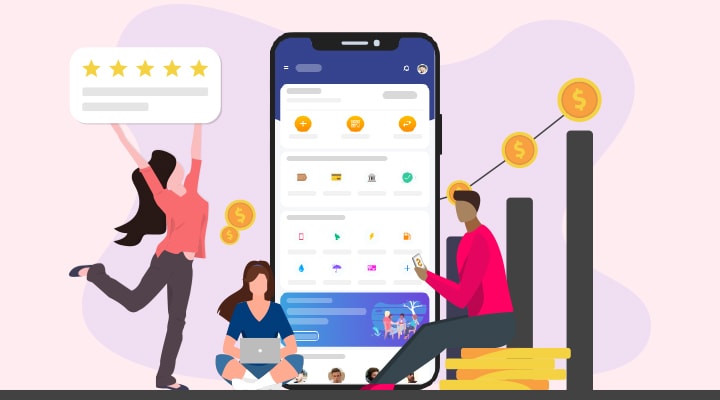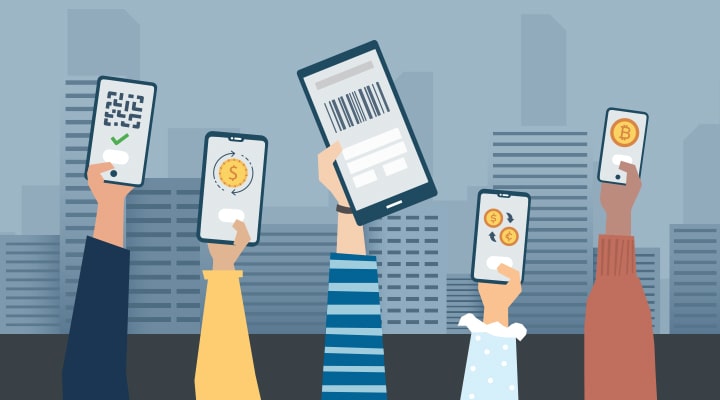The digital payment app allows us to enter into a cashless, card-less, order-at-single-click universe. They can do everything under the sun like splitting bills, sending remittances, booking trips, managing expenditures. Mobile money and Fintech possibilities revamp our ways with mobile money transactions with mobile wallet apps, m-commerce apps, cryptocurrency platforms, peer-to-peer payment apps, and whatnots! One day we might wake up to a bankless world.
Let’s understand more about the digital payment app.
Table of Contents
What is a Digital Payment App?
The digital payment app is like an online wallet where you can store your money digitally and use it for various online and offline transactions. It can be linked to your mobile number and your bank account to facilitate quick, easy, and secure monetary transactions. You can then enter the necessary details, or scan a code to do transactions.
Now that you understand the digital payment app,let’s talk about how to build an ultimate digital payment app.
Here are a few Tips to Build an Ultimate Digital Payment App
1. Hunt for The Bug and Crashes
The most annoying thing on the digital payment app is when the user first sees slow loading or has an endless loop of error messages. This is the time when you have to ensure that no bugs are bothering your users. The client needs to lessen the app size so that users can download it easily.

When is the best time to do this? There are two answers to this question – one is: before the launching of the app, and another is all the time. You can hunt down and destroy all the bugs that could bother users while making their purchases. For the post-launch stage, you will have to ensure that you have a reliable crash alert tool, so that you can easily solve any unexpected performance problems with the peer to peer app.
2. Ensure Secure Transactions
The most critical thing for your digital payment app is guaranteeing to have an SSL convention that enables you to encode data of credit card, debit card and other sensitive data of individuals who are dreadful of online scams taking place on the web exchanges.
3D Secure authentication is also useful to make cardless transactions. It involves three domains: bank,peer to peer app, and bank. This authentication works on tokens or biometrics to authenticate cardholder information. This will decrease the number of frauds. The liability on every verified transaction will get shifted from a merchant to the issuing bank.
3. Keep It Simple
Filling the credit card details on an app should be less time-consuming. The longer does it take, the more likely a user will get trouble with the payment experience, maybe he can change his mind too. You have to ensure the automatic formatting of the user’s card number and its expiry date. You can also use a virtual keyboard or the automatic field selection as soon as the user will finish it.
4. Put your Feet in User’s Shoes
“Give before you get” is the mindset behind making a peer to peer app. If you want to create a successful mobile money payment solution, you first need to know how the user sees your digital payment app. Give them the features to rate the app, allow notifications, or purchasing goods or services.
Users need to be comfortable with your digital wallet solution through crypto payment processor. The easy way to get a picture of your digital payment app’s usability and user happiness is qualitative analytics, which shows you exactly how users interact with your app.
Qualitative analytics not only shows the numerical user data but also a real-time glimpse into their experience of your app. This way, any issues regarding your digital payment app will immediately make themselves evident, enabling you to address them quickly and confidently.
5. Break the payments before Checkout
Sometimes the digital payments can get annoying. Maybe the user accidentally entered the product twice. Perhaps they did not check the shipping costs before placing the order and were surprised to see a huge amount deducted from their account.
A suitable method of preventing these issues calls for you are to display the order details, shipping address, and total price every time. This way, your users know exactly what is in their cart and where they will receive it, and they will be able to edit their order before hitting the “order” button.
6. Carefully do Profitable Partnerships
Customer security and convenience are the key factors for building mobile app. Consumers don’t want to sign up for many apps to pay for each transaction. A peer to peer app must allow their customers to use their preferred method of payment under one roof.
For instance, one consumer might want to use a credit card at Amazon, pay for his fuel via UPI and need a debit card for other payments. Customers will not download all the apps to make payments every time. Thus any peer to peer app has to allow all of the payment methods. Mobile money and fintech possibilities will ease this task for you.
Summing Up
Ultimately, the effective digital wallet solution can have a significant effect on a company’s bottom line. By the time a user reaches the dashboard intending to buy, the app has gotten everything right. It provided a great experience, offered enticing items, and encouraged the user to make a purchase.
A single payment issue in a peer to peer app can make all that hard work go to waste. Fortunately, with a little research, a lot of testing, and a healthy dose of empathy, your digital payment app can end in a win-win for both you and the use.












